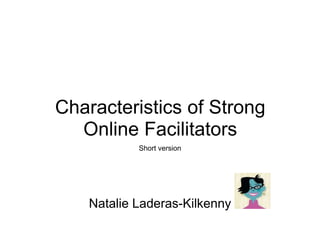Characteristics of strong_online_facilitators
- 1. Characteristics of Strong Online Facilitators Short version Natalie Laderas-Kilkenny
- 2. Online facilitatorsŌĆ” are open to learning new tools
- 3. ŌĆ”are online community builders/seeders
- 4. ŌĆ”can adapt their approach to different students' communication styles. One approach Differentiated
- 6. ŌĆ”know how to give feedback Approval Statements Neutral Correction Private Public Positive Genuine
- 7. ..understands how to "emote" online
- 8. Guess the emoticon... D8 : -9 0:-) ( ) : /
- 9. Online facilitatorsŌĆ”realize that there are limitations to online communication, but compensate
- 10. ŌĆ”are inventive and innovative
- 11. ŌĆ”are mindful of time and organize tasks accordingly
- 12. ŌĆ”online facilitation is hard & rewarding work...
Editor's Notes
- #3: But they also incorporate time-tested methods and approaches to teaching. We've all seen them or even been in an online class taught by one of them. The reluctant professor or instructor who is only teaching the course online because he's required to do so.┬Ā You don't have to be an expert at using the technology, much of the skills at working online are mastered with a little practice. But possessing a positive attitude about the technology and media can mean the difference between a memorable/valuable and horrible experience for both the teacher and the students.┬Ā SUGGESTION: make sure to screen your instructors for willingness to learn and embrace new technology. Sometimes the fact that they're active outside of their profession in Twitter, Facebook, Ning or other social media may indicate that they have some of the skills and aptitude necessary for being an online instructor. Page URL: http://mrg.bz/5bYPJU Image URL: http://mrg.bz/VjPMMi
- #4: Skills and behaviors include: Being able to ask thought and discussion generating questions. Encourages and inspires sharing amongst students? Guides students to collaborative work and cooperation. Models networking and sharing.
- #5: Example: sometimes forums donŌĆÖt work for everyone. Maybe a facilitator needs to make a personal connection with someone via e-mail or chat. Also some students online may need additional scaffolding to understand how to effectively work online, collaborate and contribute.
- #6: Bruce Lee had it right.┬Ā ┬Ā In a presentation I saw a while ago at a distance learning conference, I learned that Eastern Philosphy of teaching and learning can be applied to teaching online.┬Ā ┬Ā Scot Robinson made the point that facilitators are responsible for directing the flow of energy during an online training. Through their questions, they can help generate meaningful conversations that reinforce and promote extended learning.┬Ā They can also engage students in online participation in knowledge building via wikis and blogs. They can design creative activities and applications of these technologies to promote learning via collaboration. ┬Ā ┬Ā Robinson also cautions we Westerners to ease back on the ŌĆ£activeŌĆØ or ŌĆ£dynamicŌĆØ approach to doing things.┬Ā As he said ŌĆ£Westerners are tuned into actionŌĆ”ŌĆØ and itŌĆÖs hard for us not to act when we see a opportunity or problem. Instead, the savvy online educator should practice Wu-wei or ŌĆ£actionless action.ŌĆØ┬Ā Following the line of thinking that encourages the teacher to contribute to the flow of energy in a learning activity, the teacher must observe the flow and ŌĆ£go with it.ŌĆØ ┬Ā http://nkilkenny.wordpress.com/2009/07/10/applying-eastern-philosophy-to-online-learning/
- #7: Ideal feedback practices: *Corrects privately. *Is positive when providing feedback. *Uses ŌĆ£approval statementsŌĆ£ and neutral correction *Is always genuine.
- #8: Unlike a face-to-face conversation, you cannot read the recipient's nonverbal responses to know whether the approval was well received. ┬Ā Facilitators can encourage use of clarifying statements. ┬Ā ┬Ā
- #9: The emoticon in Western style is written most often from left to right. Thus, most commonly, one will see the eyes on the left, followed by the nose and mouth. Typically, a colon is used for the eyes of a face. However, an equal sign, a number 8, and a capital letter B are also used interchangeably. Answers: Angel Skeptical Hugs Disgust Yum (licking one's chops)
- #10: I knew an instructor who actually made use of the podcasting feature in Sakai. This was a built in voice sharing feature in the LMS. At the beginning of each week she would record a brief message that did at least three things. Gave a short summary of the assignments and activities that were due that week. Gave an update on when she would be available via "chat" for office hours. Shared one thing she was excited about about the classwork, activities or just the week in general. ┬Ā
- #11: Being able to express yourself in writing is definitely a key skill to have as an online facilitator; however, being able to read when things are ŌĆśwrongŌĆÖ or even probing students for more feedback to determine what they need are key skills to have. Being able to express oneself succinctly but also use multiple avenues of communication is important to successful online facilitation.
- #12: Some timesaving/organizational things effective online facilitators do. Always answer questions and perform tasks at the same time of the day.┬Ā Includes:┬Ā grading, check in with students, comments. Limit the number of comments. Engage in discussion with all students rather than just individual ones. If needed offer regularly scheduled meeting times or chats to connect with students.
- #13: ŌĆ” and can have positive impact ItŌĆÖs important to help communicate this to prospective facilitators before they sign on. Also, design is only the first part of successful facilitated online learning. Thorough instructor prep and support is yet another part of the equation.












